E. Coli Symptoms: 17 Fall Ill As Dangerous Strain Strikes 13 US States

After Canada, now the United States is in the grip of an E. coli outbreak. The U.S. Centers for Disease Control and Prevention (CDS) started an investigation after 17 people fell ill across 13 states between Nov. 15 and Dec. 8.
The authorities are examining whether the present case is connected to a similar outbreak in Canada that was linked to romaine lettuce. The strain of E. coli identified in the outbreak in the U.S. — Shiga toxin-producing O157:H7 — is considered very dangerous that can cause deadly illnesses, NBC New York reported. A total of 41 cases of E. coli 0157, including 17 hospitalizations and one death, were reported in Canada in the months of November and December.
According to a release from CDS, the illness started in the U.S. between Nov. 15 and Dec 8. So far two cases were reported from Connecticut, two from New Hampshire, three from California and one each from New York, Vermont, Pennsylvania, Illinois, Indiana, Ohio, Michigan, Nebraska, Virginia and Washington.
CDC was performing whole genome sequencing on samples of bacteria to identify the source of the outbreak and to see whether it was linked to the illness in Canada. Preliminary results showed that the type of bacteria that affected people in both countries was “closely related genetically,” the NBC report added.
Health officials started interviewing the affected people to determine what they ate in the week before they fell ill. The agency said it "is still collecting information to determine whether there is a food item in common among sick people, including leafy greens and romaine."
CDC spokeswoman Brittany Behm told Healio that five patients were hospitalized in the U.S. so far. She added that two of them developed hemolytic uremic syndrome(HUS), a life-threatening complication of Shiga toxin–producing E. coli infections that is commonly found in children aged below 5 years and older adults.
E. coli or Escherichia coli are a large and diverse group of bacteria, normally found in the intestines of people and animals. Although most strains of the bacteria are harmless, some types cause diarrhea, urinary tract infections, respiratory illness and pneumonia, and other illnesses. E. coli O157:H7 and other strains that cause intestinal sickness are categorized as STEC.
The symptoms include loss of appetite, fatigue, severe abdominal cramping, diarrhea and fever. More adverse cases would lead to bloody diarrhea, dehydration and even kidney failure. People with weak immune systems, pregnant women, children, and elderly persons are more prone to develop these complications. One of the major causes for intestinal infections is contaminated food or water.
People start showing the symptoms generally between 1 and 10 days after getting infected with E. coli — known as the incubation period. The symptoms usually last around 5 to 10 days, reported Healthline.
According to the CDS, about 5 to 10 percent of infected persons develop, where the red blood cells are damaged. It can lead to kidney failure. HUS generally begins about 5 to 10 days after one develops diarrhea, it added.
© Copyright IBTimes 2024. All rights reserved.











